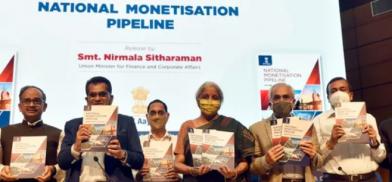Transparency, institutional checks and balances must for success of India’s ambitious asset monetization plan
If asset monetization is undertaken with strict oversight, it can be the most effective remedy to dispel the pervading gloom of an ailing economy, writes N Chandra Mohan for South Asia Monitor

For India’s BJP-led National Democratic Alliance government it is a challenge to revive growth in the nation’s output of goods and services or GDP to become a USD 5 trillion economy in five years. Towards this end, the Union Budget for 2021-22 outlined an infrastructure-led push for growth, besides a sweeping agenda for privatization of non-strategic public sector undertakings and asset monetization.
Six months later, a National Monetization Pipeline has been unveiled to monetize public assets like roads, railways, power transmission, warehouses, airports, natural gas pipelines, telecom towers, among others, to partly fund the government’s infrastructure plans over the next four years.
Simply put, monetization entails the creation of new sources of revenue by unlocking the value of investments made in public assets under the government’s control -- including stakes in public sector undertakings -- which have not yielded appropriate returns or are being under-utilized. The initiative seeks to unlock the value of public assets currently in operation which will remain in the government’s control. Union Finance Minister Nirmala Sitharaman emphasized that “the government is not selling away these assets”.
All that is being done is to invite private participation in the brownfield projects so that they become value-accretive as a result of efficient operation.
The National Monetization Pipeline is an integral part of the government’s National Infrastructure Pipeline which was released a couple of years ago. This envisaged INR 111 trillion of investments by 2024-25 on roads, railways, housing and cities, conventional and renewable power, irrigation, etc. However, monetization of the brownfield assets is only a small part of this massive infrastructure drive as it is expected to raise INR 6 trillion or only 5.4 percent of this massive outlay. But the government appears intent to hit the ground running by setting a target this financial year of garnering INR 882 billion.
Role of private sector
Public-private partnerships or InvITs are the preferred modes for asset monetization. In the case of railways, which account for 25 percent of assets to be monetized in the next four years, PPPs are expected to redevelop 400 railway stations, run 90 passenger trains, lease the track on dedicated freight corridors, etc.
In the case of passenger trains, there is a model concession agreement in place to operate these trains for a period of 35 years in return for an upfront payment, track access charges, revenue sharing and commitment of investments. The private partner will have the right to collect fares and avail of the railways’ maintenance infrastructure.
Infrastructure investment trust or InvIT is another mode for raising investible funds for new or incomplete projects. These trusts are akin to mutual funds which enable investors to buy units in these trusts listed on stock exchanges and thus have a share in the income stream of these vehicles in the form of dividends and unit distribution.
InvITs will play a big role in power transmission and road projects. The Power Grid Corporation of India has successfully monetized some of its transmission projects through its PGInvIT. The government now has raised its level of ambition in targeting 28,608 circuit kilometers of transmission assets.
Asset monetization will take off only if the private sector is on board. India Inc has to do the heavy lifting also for the National Infrastructure Pipeline, contributing a fifth of the required expenditures. Foreign direct investments and other long-term sources of patient capital are welcome but their track record in infrastructure investments has not been very encouraging.
Transparency, proper business environment
According to the National Infrastructure Pipeline report, the share of infrastructure to total FDI is fairly stable at relatively low levels of 28 percent and much of the flows have gone into communication services and the power sector between the fiscal years 2010-11 and 2018-19.
The dependence thus is more on local sources of capital to push infrastructure-led spending, which calls for creating an enabling business environment. Investments, both domestic and foreign, are sensitive to policy and regulatory uncertainty.
India Inc’s animal spirits are low, thanks to a persisting “trust deficit” with the government. For instance, the absence of a regulator to ensure a level playing field between private and government-run trains can bedevil the efforts to target the running of 90 trains on a PPP basis in the National Monetization Pipeline. Enthusing Indian industry to make the necessary investments is easier said than done.
To ensure the Indian industry’s participation, asset monetization must be implemented with utmost transparency. There must be a balance between risk and reward, between public and private interests. Asset monetization will be a fraught exercise if the various projects are cornered by a few private parties.
But if it is undertaken with strict oversight and with the necessary institutional checks and balances, it can be the most effective remedy to dispel the pervading gloom of an ailing economy as such infrastructure investments can set in motion a virtuous cycle for faster growth towards a USD 5 trillion economy.
(The writer is an economics and business commentator based in New Delhi. The views expressed are personal. He can be contacted at nchandramohan@rediffmail.com)









Post a Comment